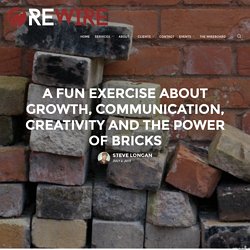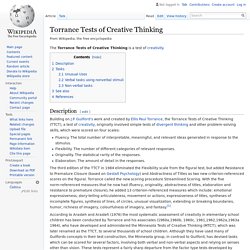

A Fun Exercise About Growth, Communication, Creativity And The Power Of Bricks. I get to do a lot of interesting stuff for my work with Rewire.

For instance, I wrote a few weeks ago about some eye-opening research I was doing on making better decisions. One of the other fun things I get to do with Rewire is design exercises for us to use in workshops, keynotes, retreats, etc., and today’s article is about one such exercise. We’ll talk about: (1) How the exercise is setup, (2) what almost always happens with people as they do this exercise, and (3) what this means for sustainably growing our work. 1.
How the exercise is set up. Take a group of people (needs to be bigger than 15; less than 100) and split them into two groups.Each group is given a brick.Both groups get a facilitator to explain a task to them.One group gets a positive and engaged leader who tells them that their task is to come up with as many uses as possible for the brick they’ve been given. 2. 3. 3 ways this exercise applies to sustainably growing our work (though I could give 10 more easily) When Is a Brick Not a Brick? - Sharon Begley. What can a brick be used for?

Well, there's building a house, breaking a window, holding down a pile of papers on a windy day, squashing a bug, paving a driveway, building a wall, as the legs of a small table … Now take a break and shift your eyes from left to right and back again for 30 seconds. If psychologist Elizabeth Shobe of Richard Stockton College of New Jersey and her colleagues are right, that ocular exercise spurred creative thinking, enabling you to come up with yet more uses for a brick (perhaps putting in the toilet tank to reduce water usage? Creative Thinking Techniques - Forty Uses For A Brick. Creativity Tests. Which way is she turning?

Are you left brained or right brained? Watch the girl below, if you see her turning clockwise, you are probably left brain dominate, if you see her turning counterclockwise, you are most likely right brain dominate. Here is another test on hemispherical dominance by Synergistic Learning Incorporated. Download Brain.exe (Windows OS) Here's another : (click the image) Creativity tests are typically divided into four main components: Divergent thinking, Convergent thinking, Artistic assessments and Self assessments.
Divergent thinking is the ability to consciously generate new ideas that branch out to many possible solutions for a given problem. Convergent thinking is the ability to correctly hone in the single correct solution to a problem. Insight ProblemsRemotes Associations Task (Mednick) Artistic assessments are the evaluations of an artistic product (e.g., painting, story, poem, musical composition, collage, drawing etc.). Barron-Welsh Art Scale Other Assessments. Torrance Tests of Creative Thinking. The Torrance Tests of Creative Thinking is a test of creativity.

Description[edit] Building on J.P. Guilford's work and created by Ellis Paul Torrance, the Torrance Tests of Creative Thinking (TTCT), a test of creativity, originally involved simple tests of divergent thinking and other problem-solving skills, which were scored on four scales: Fluency. The total number of interpretable, meaningful, and relevant ideas generated in response to the stimulus.Flexibility. The third edition of the TTCT in 1984 eliminated the Flexibility scale from the figural test, but added Resistance to Premature Closure (based on Gestalt Psychology) and Abstractness of Titles as two new criterion-referenced scores on the figural. To date, several longitudinal studies have been conducted to follow up the elementary school-aged students who were first administered the Torrance Tests in 1958 in Minnesota.
Verbal tasks using verbal stimuliVerbal tasks using non-verbal stimuliNon-verbal tasks Tasks[edit] Test Your Creativity: 5 Classic Creative Challenges. Fascinated by how brains and creativity work, we frequently share new research on the 99U twitter feed, showing how everything from drinking alcohol, to taking vacations, to moving your eyes from side to side can make you more creative.

What’s particularly interesting, however, is that most of these studies rely on just a small group of core creativity tests – and you don’t need any special lab equipment to take them. Below, we’ve collected five of the most commonly used creativity challenges for your self-testing pleasure. While creativity “testing” is far from an exact science, trying your mettle at these challenges could yield insight into when, where, and how you’re most creative. Or maybe it’ll just be fun. 1. Developed by J.P. Hold papers togetherCufflinksEarringsImitation mini-tromboneThing you use to push that emergency restart button on your routerKeeping headphones from getting tangled upBookmark The test measures divergent thinking across four sub-categories: 2. 3. 4. 5.